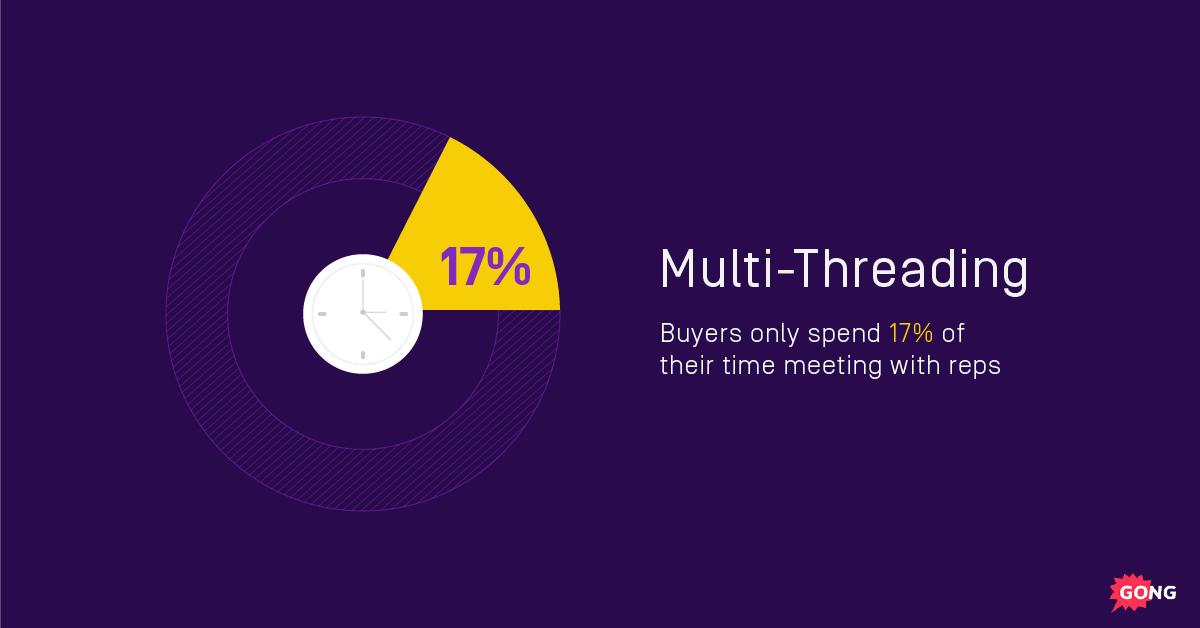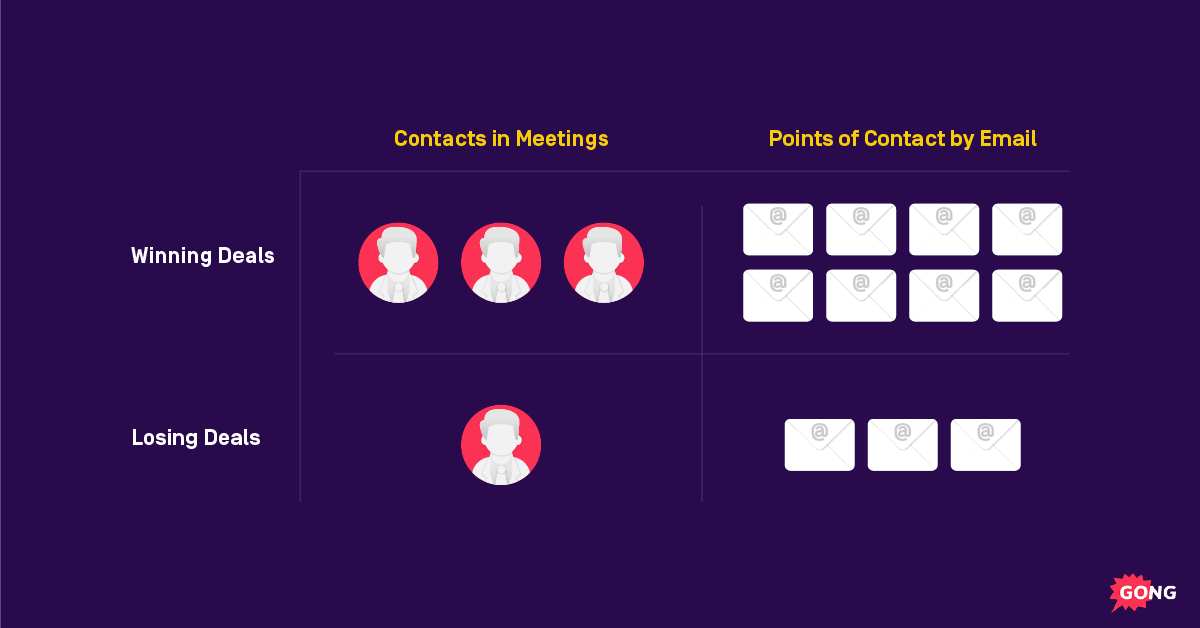Lou Wolf: The #1 Signal a Deal Won’t Close
What kinds of data can you use to drive decisions?
How does multi-threading impact win rates?
Why is developing new leaders essential to scaling your organization?
On a recent episode of the Reveal podcast, we connected with Lou Wolf, VP of New Business Sales at Zoominfo (powered by DiscoverOrg), for answers to these and other questions that are top of mind for revenue leaders.
Key Points to Remember
- Transitioning from a sales role to a leadership role requires a completely different mindset.
- Focus on the long term and spend your time on things that get you big wins.
- Multi-threading is critical for maximizing your win rate.
- Sales team interaction and clarity of roles are two essential components of a successful merger.
- The number one thing you can work on is developing new leaders.
Transitioning to Leadership
The hardest transition was the first time going into leadership. Getting out of the AE role, having my own book of business, and total control over what I was doing. Then all of a sudden being a manager of the team.
That was something I really badly wanted to do. I was all excited for it. I knew I could do it. I’ve been a team lead. I’d helped on ramp tons of reps. But what I didn’t realize is that when you really make that change, all the things you’re looking at, and all the things you need to do to get ahead of your number, are totally different. You can’t do it yourself. You can’t take the quota of eight people and go run every deal. You have to become a leader and a manager.
You’ve got to make sure you’re still there and you’re not just barking all day. But you have to get this discipline to change what you’re doing and own your time.
Focus on the Big Picture
I think first it’s really just taking good looks at the goals. The objectives the company wants me to get to, laying that out, and then organizing myself and saying, “All right, what are the things I need to do to get there?” And crossing out all the little things that might win you one deal or might help in the super short term. That’s not a sustainable path.
Looking long term and making sure you’re spending your time on things that get you big wins is the biggest key. And whenever the job gets super daunting, I can usually look back and say, “All right, I’m spending time on things that aren’t big enough.”
You listen to a call of a relatively new rep, and you want it to be perfect. When you hear things that aren’t great, you want to jump in and just take care of it. But you have to sit back and remember—there’s a growth progression, and it’s okay that not everything goes perfectly as long as it’s getting better over time. Holding yourself back to make sure you’re developing people that way is really key.
Data-Driven Actions
Data is part of every decision around here. We’re using data to inform every decision we make. I don’t think there are too many companies out there that have a team organizing information for their sales leaders’ decisions better than us.
If we’re thinking about price changes, we’re getting all the data on how every different segment interacts in the price points that they’re buying at, and the types of products they’re buying. And if you’re wondering why small companies are buying certain products, we’re pulling all this information to see and analyze the trends over time.
We run dozens of sales campaigns a month, and we measure each one. We know what our open rate is. We know what our response rate is. We know how many of the deals that were part of that campaign are actually won.
Key Sales Metrics
We start out with our results. I have revenue and revenue per product. I have our average order size, which is an important step for us. I have our trailing 90 win rate. Then I have, from an objective standpoint, pipeline metrics.
We’re looking at how many meetings my team is getting. How many meetings my team is considering good and moving onto an opportunity, versus how many they think aren’t a good fit. Quotes that are out. DocuSigns that are out.
We have a really good idea of our forecasting pipeline from those types of metrics. When you’re watching that, it gives you an extra check down to the team forecast and team roll up that can help you feel a lot more confident in where you’re going.
There are activities which we really focus on at the manager level. You can go have the team do this and that to influence the result. You can’t just say, “Get to this revenue number.”
Multi-Threading to Win More Deals
One of the things that we’re watching closely right now is how many of our opportunities are single-threaded. Where our interactions and activity are just with one person in the opportunity.
We’re actually tracking how many people a rep is reaching out to, and how many people at the company are replying back to us. That could be that they’re on a recorded call. It could be that they emailed us. How many people are we emailing? And so we watch how many single-threaded opportunities we have.
When we’re single-threaded, our win rate is drastically lower. And when we’re engaged with multiple people in the opportunity, we have a really good idea that we can win that.
We also watch the timing of that interaction. How many interactions are happening in a given period? And so when we start to see the glare points there that scare us—we’re only dealing with one person with a lot of opportunities that are purchasing decision or closing stage—that’s not a good sign.
That will spark us managers to get involved in deals, and start talking to the rep about what happened to the other people that were in your meetings. Why aren’t they part of this? How is this gonna close? And the same with the interaction rate.
There’s seven or eight buyers in an enterprise sales cycle. So I need interaction with three or four of them at least at any given point. Whereas the commercial deal, two is fine. Two could mean we have our influencer plus the CEO in the deal, and we’re feeling really good.

Data Breakout—Multi-Threading
Gartner has research showing that during their purchasing journey, buyers only spend 17% of their time meeting with reps. Now, if those buyers are comparing multiple vendors, their time with one rep (i.e., your rep) drops to only five or six %.
That’s not a lot of time. So the best way to grow that number is by multi-threading, something Lou has thoroughly integrated into his strategy. And for good reason.
The Gong Labs team analyzed north of 50,000 sales opportunities—and the sales calls and emails within them—to understand how multi-threading impacts win rates.
Here’s what we found: Winning deals have at least three points of contact involved in meetings (defined as phone and web conferencing meetings). On the other hand, losing deals struggle to connect with more than one point of contact from the buyer’s side.
When more people are engaged in your deal, there’s also a ramp up of engagement via email, and that’s a massive predictor of deal success. On average, winning deals have eight points of contact over email, and losing deals only have three. That’s a massive 243% difference in email engagement. It’s proof that connecting with multiple stakeholders by phone, web conferencing, and email builds momentum and influences deals. In short—multi-threading simply works.
Gong’s recently released multi-threading playbook gives you ready-to-fire plays and tactical guidance on how to bring this sales motion into play.

Managing Teams Through a Merger or Acquisition
The first advice would be to quickly bring that tight interaction, help the teams understand each other, know each other on a personal level, see that they’re very much the same. The second piece would be: do your very best to give clarity—who’s working what and why.
The sooner you can let everybody understand what their charge is and what the territory they own is—so that they can be ultra responsible for that territory—the better off you’re going to be. So just getting all over that, along with bringing the teams together, making sure they know each other, and that you’re instantly sharing best practices across the whole team and getting rid of silos. Those are the biggest things.
Developing New Leaders
I think the number one thing you can work on is how to better develop those leaders. How do you teach your managers to manage their reps? How do you teach them to look at activities in diagnostics that actually influenced the teams ultimate behavior, and not just look at results.
That’s the number one skill to develop in an organization. If you influence, if you have great leaders that know how to coach the reps, your team will scale really well. If you don’t have the leadership that knows how to scale the reps, you’re going to have turnover, burnout, frustration.
You’ll have leaders that are doing the job of a rep, and that’s really hard to scale.
Subscribe to Reveal: The Revenue Intelligence Podcast
Every week, we interview senior revenue professionals who share their insights on how they leverage revenue intelligence to drive success and win their market.
You’ll hear how modern go-to-market teams win, close revenue with critical deal insight, and execute their strategic initiatives—plus all the challenges that come along with it.
Listen now at gong.io/podcasts.